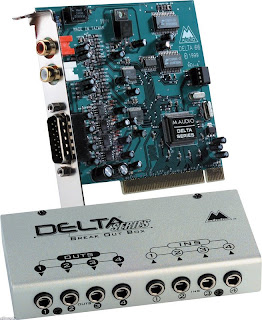Hardware Essentials - The basic hardware needed to turn your computer into a music making machine
A/D Converter
Analog to digital converters come in many shapes and sizes: some are soundcards that plug into a PCI slot on the motherboard, while others comprise a PCI card and break out box offering more connections, such as the M-Audio Delta 66 in the picture above. There's also a trend towards running audio in and out via the USB or FireWire ports, which is good news for laptop owners who can't fit PCI cards into their machines.
__________________________________
Getting MIDI in and out of the computer is an important consideration if you're planning to use a keyboard. The more ports are better, if you plan to expand the system with external sound sources and other MIDI kits. The Midiman 4x4 port, pictured above, is a typical example of a MIDI box that plugs into the USB port. It offers four input connections and four out, which should be enough for a basic project studio. Some analog to digital converters have MIDI built in along side the audio ports, so you could save time by buying a combined unit.
__________________________________
Controller Keyboard
While it's possible to enter notes into sequencing software with just the mouse, musical keyboard entry is far more intuitive. And you don't have to be a trained piano player, either. Sequencers offer step time entry, by which you can poke in one note at a time, then edit the precise timing and pitch later. While you could go for a full weighted, 88 key piano, there are plenty of compact, two octave models that do a great job. In common with controller keyboards from M-Audio and Evolution, the Novation Remote 25 Audio, In the picture above, also has MIDI and digital audio ports built in, a great all in one solution, along with a wealth of knobs and sliders for controlling the parameters of software instruments in real time.
__________________________________
Monitor Speakers
Most modern domestic PCs are bundled with multimedia speakers. Not great if you need the kind of frequency response that's going to help create great mixes. And headphones are not the best means of monitoring music - they tend not to have the bass response necessary. A pair of nearfield reference monitors, plus amplification, is a good vet for the home based project studio, and need not break the bank. Pictured above is a Tannoy Reveal, which can handle 50 watts RMS and has a frequency response of 65Hz (near Main hum) to 20kHz (near bat squeak). It's also available in an active configuration, which has a power amplifier built into each cabinet.
____________________________
Headphones
You wouldn't want a to monitor a mixdown of headphones, but they are essential when working with microphones. The padded ear cushions damp monitor foldback so that it doesn't spill into the mic and ruin an acoustic take. The Beyer Dynamic Dt 100s, in the picture above, are classic studio headphones, popular for their comfort and fine frequency response.
____________________________
Microphone
Crucial when capturing vocals and other acoustic instruments, a good microphone is essential for project studio owners. The Shure SM58, in the picture above, is regarded by many as a superb vocal mic. It's a dynamic model which means it does not require power, and is ideal for use in live situations. For general purpose applications, consider the Shure SM57, a good all around mic. Further up the price scale you'll find condenser microphones, which need 'phantom power' (48 volts) to operate. Ensure your digital-audio interface has a phantom power facility.
____________________________
Related posts:











10 comments:
Great blog, and this is a good general guide on what to get. I'd add to monitors that placement is just as important.
I've actually started a blog where I scour the internet for current deals and specials on this kind of gear (basic USB/firewire audio interfaces, mics, etc.) at:
Chordhound.com
Informative post. PC speakers are indeed not enough especially if the room is quite big.
Do you think it is worth it to buy a condenser mike, or is something like the SM58 or SM57 good enough for recording vocals (as you mentioned). Thanks for the info!
Lance
I really want to turn my PC into a stereo machine. It doesn't look so difficult. However, it's not easy for me, but I would it try sometime. Thanks for info.
Thanks for this informative guide. I also wanted to turn my PC into a music machine but I didn't know what hardware to hook it up with. This post give me the information I've been looking for.
thanks for the basic info about the hardware really i got it thanks for it`1
Thanks for this informative post. thinks these speakers a needed in a very spacious environment like big party halls.
Thanks for the great info, keep up the excellent work. I will be sure to pass it on. Get a free forex account here today Practice Forex Account. Thanks
Pretty good post. I just stumbled upon your blog and wanted to say that I have really enjoyed reading your blog posts. Any way I'll be subscribing to your feed and I hope you post again soon.
There are some devices which turns in to sound devices, This is one example, Also i have seen the pop singers make the same way, this hardware devices which you have put up here is very useful for them.
Post a Comment